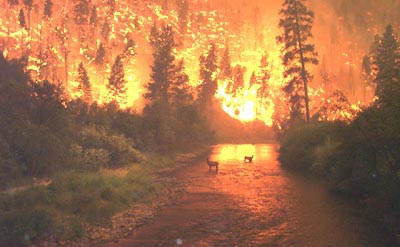The Science of Wildfires

Photo courtesy Bureau of Land Management/John McColgan In 2000, this wildfire burned just north of Sula, Montana.
It’s wildfire season and people across the country watch the conditions and the weather hoping their home will be spared.
Areas with dense trees, grass, shrubs or other plant growth are more susceptible to wildfires, especially after a wet season in spring followed by a dry season in summer.
According to How Stuff Works, an average of 5 million acres burn every year in the United States, threatening homes, property and the lives of those in the fire area.
The largest fire in Arizona history, the 841-square mile Wallow Fire is now 77% contained. Two other large fires – the Horseshoe Two and the Monument Fire have also raged across the state this June. The Horseshoe Two in southeastern Arizona burned over 348 square miles and is now completely contained. The Monument Fire near Sierra Vista is about 85% contained after burning 47 square miles and destroying 57 homes.
This past week, two forest rangers were killed while fighting a wildfire in northern Florida.
Smokey the Bear defines a wildfire as an “unwanted, unplanned, damaging fire burning in the forest, shrub or grass and is one of the most powerful natural forces known to people.”
A wildfire can take on a life of its own. Tearing over ridges, changing direction, looking to survive.
Some wildfires are caused by lightning or intense sunlight in dry areas, but nine out of ten wildfires are human-caused. The most common causes of fires are arson, campfires, lit cigarettes, improperly burning debris, playing with matches or fireworks and prescribed fires.
Wildfires are an ever-present danger in areas where fire suppression has allowed for the overgrowth of fire fuel such as fallen leaves, branches and excessive plant overgrowth in forest areas.
A fire needs fuel to burn, air to supply oxygen and a heat source. This forms a fire triangle. When fighting a fire, firefighters work to take away one of the pillars of the triangle, they can control and put out the blaze.
Weather also plays a huge part in wildfire birth, growth and death. Temperature, wind and moisture affect wildfires and make it harder to fight them. Drought obviously leads to favorable fire conditions. Moisture can slow the fire down. Wildfires tend to rage in the afternoon after sunlight heats sticks, trees and leaves on the ground. The radiant heat dries fuels and allows them to ignite to burn faster. Cooler temperatures help the fire lay down and give firefighters the upper hand in gaining control.
Wind has a huge impact on wildfires adding additional oxygen and pushing the fire faster. It is also unpredictable, changing a fire’s direction without warning.
Fires can develop their own wind patterns. Large fires can generate their own tornadoes, or fire whirls.
A fire tornado is just like a tornado but is made of fire instead of air. As the heated air from the fire rises, strong air currents whipping through the trees cause the air molecules to spin (rotational momentum) which shapes the flame into a tornado. The tornado rotates and rises and flames jump from tree top to tree top. These tornadoes can throw burning debris over long distances. Click here for a demonstration on how fire tornadoes are created.
For more information on the science wildfires, check out these great links:




Leave a Reply
Want to join the discussion?Feel free to contribute!